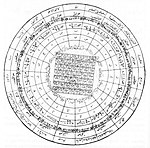Persian Bayán
| Bábi Texts and scriptures |
|---|
 |
| From the Báb |
The Persian Bayán (
Content
The Persian Bayán was written near the end of 1847 or the beginning of 1848, while the Báb was imprisoned in
Unities and chapters
The book was intended to be composed of nineteen 'unities' each of nineteen chapters, consisting of a total of 361 sections, which had numerical significance, but this was left incomplete and stops in the ninth 'unity'.
Laws
Among the main themes of the Bayán are the mystic character of action, the prohibition of causing grief to others, refinement, perfection and the spiritualization of life and language.
Right of completion
Certain early researchers of the religion believed that the right of completing the Bayán was conferred to
The Báb eliminated any form of successorship or vicegerency from his religion and stated that no one else's writings would be authoritative after his death to the time of He Whom God shall make Manifest.[12] Some of the followers of Subh-i-Azal state that the Báb actually made Subh-i-Azal his vicegerent because the Báb in a tablet written to Azal stated that he should manifest the remaining paths of the Bayán if He Whom God shall make Manifest is made manifest during Azal's days. The Azalis interpret this to mean the Báb gave Sub-i-Azal the right to complete the unfinished text of the Bayán.[12] However, the Báb affirms to Subh-i-Azal himself that He Whom God shall make Manifest may appear in Subh-i-Azal's own lifetime, and thus eliminates any viceregency for Subh-i-Azal.[14]
One of the texts that the Azalis use to state that Subh-i-Azal was appointed as a viceregent is the controversial book Nuqtutu'l-Kaq, but the book's statements are very contradictory and problematic.[12] In one section of the book the author states that the Bayán may become abrogated within a few years of the Báb's death, and that He Whom God shall make Manifest may appear during Azal's time, then later he states that the abrogation of the Bayán and the appearance of the Promised One could not occur before two thousand years. Even later the author makes the proposition that the Promised One is Subh-i-Azal himself, showing that the author truly did not believe that the appearance of the Promised One would have to take two thousand years.[12] The proposition that He Whom God shall make Manifest would take two thousand years is absurd since the Báb discusses the advent of He Whom God shall make Manifest during Subh-i-Azal's lifetime as a conditional point for Subh-i-Azal to take certain action.[12]
An alternative interpretation of the passage in question is that Subh-i-Azal is asked to instead to making public or distribute the eight copies of the Bayan to eight people mentioned in the passage.[15]
Browne and the Bayán
Edward G. Browne planned at one time to publish an edited text of the Persian Bayán, and did considerable work on the compilation of six manuscripts, but the work was never completed. This incomplete compilation, still exists in the Cambridge University Library (classmark Or. 1331–7 [11]), awaiting the attention of some future scholar.[16]
Notes
- ^ ISBN 1-85168-184-1.
- ^ ISBN 978-0-85398-247-0.
- ISBN 0-87743-020-9.
- ^ Saiedi 2008, pp. 309–336
- ^ Saiedi 2008, pp. 363–367
- ^ Saiedi 2008, pp. 309
- ^ Saiedi 2008, pp. 299
- ^ Browne, Edward (1892). "Catalogue and Description of 27 Babi Manuscripts". Journal of the Royal Asiatic Society of Great Britain and Ireland: 478–479.
- ^ Nicolas, A.L.M (1905). Le Beyan Arabe. Paris: Ernest Leroux, Editeur.
- ^ Browne, Edward (1891). A Traveller's Narrative. Cambridge University Press. p. 353.
- ^ Saiedi 2008, pp. 403–404
- ^ a b c d e f g Saiedi 2008, pp. 344–348
- ISBN 978-0-521-86251-6.
- ^ Saiedi 2008, pp. 344–345
- ^ Saiedi 2008, pp. 347
- ISBN 978-90-04-09462-8.
References
- Saiedi, Nader (2008). Gate of the Heart: Understanding the Writings of the Báb. Canada: Wilfrid Laurier University Press. ISBN 978-1-55458-056-9.
Further reading
- بيان فارسى Bayan-i-Farsi
- ISBN 1-931847-30-4.
- Browne, Edward Granville (1987). "A Summary of the Persian Bayan". In Momen, Moojan (ed.). Selections from the Writings of E.G. Browne on the Bábí and Baháʼí Religions. Oxford, UK: George Ronald. ISBN 0-85398-247-3. Archived from the originalon 2007-10-14.
- Thomas, James B. Seeds of Revelation and the Mystic Bond between The Báb and Baháʼu'lláh: An Exposition on Excerpts from the Persian Bayán. In Lights of Irfan, Volume 7 (2006).
